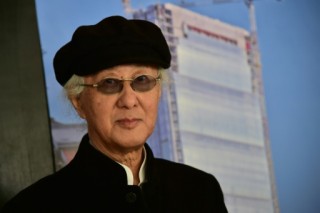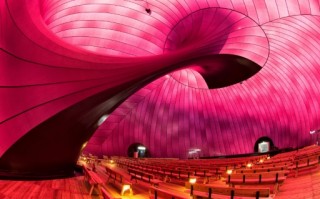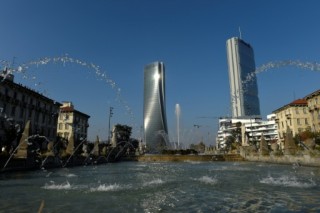Loading
Search
▼ Japanese Architect Isozaki Wins Pritzker Prize
- Category:Event
NEW YORK- Japanese architect Arata Isozaki has been awarded the Pritzker Prize, considered architecture's highest honor, for a lifetime of work that found global resonance while mining local traditions.
The 87-year-old's more than 100 built works range from the Palau Saint Jordi, built in Barcelona for the 1992 Summer Olympics, to the Museum of Contemporary Art in Los Angeles, his first international commission.
His hometown of Otai, Japan is a showcase of his early work, including a medical hall and annex, and a prefectural library.
"Isozaki is a pioneer in understanding that the need for architecture is both global and local -- that those two forces are part of a single challenge," the chair of the jury, U.S. Justice Stephen Breyer, said as the prize was announced Tuesday.
"For many years, he has been trying to make certain that areas of the world that have long traditions in architecture are not limited to that tradition, but help spread those traditions while simultaneously learning from the rest of the world," he said.
Isozaki is the 46th Pritzker laureate and the eighth Japanese architect to receive the honor. Winners receive a bronze medallion and $100,000.
The prize will be awarded in May at a ceremony in Paris.
His office of Arata Isozaki & Associates, in Tokyo did not have an immediate comment on the announcement.
Isozaki is considered one of the first Japanese architects to have absorbed western styles and influences into his work, and spent much time in the west traveling and studying.
But his interest in cultural diversity was sparked by the influence of American culture in post-WWII Japan -- whose cities had just been devastated by U.S. aerial bombing -- when his country was occupied by US troops.
The 87-year-old's more than 100 built works range from the Palau Saint Jordi, built in Barcelona for the 1992 Summer Olympics, to the Museum of Contemporary Art in Los Angeles, his first international commission.
His hometown of Otai, Japan is a showcase of his early work, including a medical hall and annex, and a prefectural library.
"Isozaki is a pioneer in understanding that the need for architecture is both global and local -- that those two forces are part of a single challenge," the chair of the jury, U.S. Justice Stephen Breyer, said as the prize was announced Tuesday.
"For many years, he has been trying to make certain that areas of the world that have long traditions in architecture are not limited to that tradition, but help spread those traditions while simultaneously learning from the rest of the world," he said.
Isozaki is the 46th Pritzker laureate and the eighth Japanese architect to receive the honor. Winners receive a bronze medallion and $100,000.
The prize will be awarded in May at a ceremony in Paris.
His office of Arata Isozaki & Associates, in Tokyo did not have an immediate comment on the announcement.
Isozaki is considered one of the first Japanese architects to have absorbed western styles and influences into his work, and spent much time in the west traveling and studying.
But his interest in cultural diversity was sparked by the influence of American culture in post-WWII Japan -- whose cities had just been devastated by U.S. aerial bombing -- when his country was occupied by US troops.
He was intrigued at an early age by the contrasting aesthetic codes of the two countries, as he joined a new generation of Japanese architects rebuilding their flattened cities.
With his swept-back gray hair and penchant for Chairman Mao-style shirt collars, the distinguished Japanese architect has designed buildings on four continents, from sports venues to office buildings and museums.
His works have built on the philosophy of his mentor Kenzo Tange, a modernist architect whose own works are scattered around the globe and who took the Pritzker himself in 1987.
Aside from his cosmopolitan outlook, Isozaki is also known for never confining himself to one set style, showing more interest in integrating each of his constructions into their individual settings.
"My pleasure is to create different things, not the same thing," he told the website ArchDaily in 2017. "For the media or identity and so on, (it's) very confusing."
The two main elements of his work -- cosmopolitanism and the desire to meld with the environment -- found their apotheosis in Barcelona's Palau Sant Jordi.
With his swept-back gray hair and penchant for Chairman Mao-style shirt collars, the distinguished Japanese architect has designed buildings on four continents, from sports venues to office buildings and museums.
His works have built on the philosophy of his mentor Kenzo Tange, a modernist architect whose own works are scattered around the globe and who took the Pritzker himself in 1987.
Aside from his cosmopolitan outlook, Isozaki is also known for never confining himself to one set style, showing more interest in integrating each of his constructions into their individual settings.
"My pleasure is to create different things, not the same thing," he told the website ArchDaily in 2017. "For the media or identity and so on, (it's) very confusing."
The two main elements of his work -- cosmopolitanism and the desire to meld with the environment -- found their apotheosis in Barcelona's Palau Sant Jordi.
Completed in 1990 as the stage for the Olympic Games gymnastic events two years later year, the domed venue is partially sunken into the summit of the Montjuic hill overlooking Barcelona, so that it appears to be part of the hill itself.
In Japan, his most celebrated works include the Kitakyushu municipal museum of art, built in 1974, and the Kamioka town hall from 1978, which reflect the architect's eclecticism: the former is all straight lines and sharp angles, while the latter is liquidly smooth and curvaceous.
Isozaki is also deeply attached to the Japanese concept of 'ma' which relates to the sense of space separating two objects.
Last year, the Pritzker Prize was awarded to 90-year-old Indian Balkrishna Doshi.
© 2019 AFP
In Japan, his most celebrated works include the Kitakyushu municipal museum of art, built in 1974, and the Kamioka town hall from 1978, which reflect the architect's eclecticism: the former is all straight lines and sharp angles, while the latter is liquidly smooth and curvaceous.
Isozaki is also deeply attached to the Japanese concept of 'ma' which relates to the sense of space separating two objects.
Last year, the Pritzker Prize was awarded to 90-year-old Indian Balkrishna Doshi.
© 2019 AFP
- March 6, 2019
- Comment (0)
- Trackback(0)




